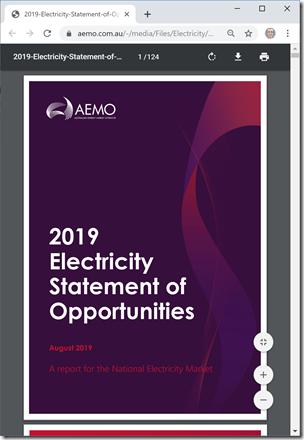This morning the AEMO released his 2019 Electricity Statement of Opportunity a few days prior to the 31st August deadline – you can access it at the linked image below:
| Understandably, given the content, there was significant media coverage of some of the core messages included in this planning document:
1) In the AFR, Angela Macdonald-Smith and Mark Ludlow write how “Victoria prone to blackouts this summer as grid wilts” in a front page story. The AEMO CEO, Audrey Zibelman also contributes “How to avoid blackout summers”. 2) Over at the Australian, Andrew White and Perry Williams write about “Risk of summer blackouts rises with more generator failures”. 3) In the Age, Nick Toscano and Peter Hannam provide the article “Power cuts may hit as many as 1.3 million Victorian homes this summer”. 4) On the ABC, Richard Willingham wrote “NSW, Victoria warned of summer blackout risk if power supply doesn’t improve”. 5) On RenewEconomy, Giles Parkinson writes “AEMO worries about ageing coal fleet and summer extremes, wants new tools”. …. and there will no doubt be many more articles written in the days, weeks, and months ahead. |
The headline of this is story is that it’s one more reminder that the NEM is facing heightened risk, for a collection of different reasons.
We’re grateful that guest author Allan O’Neil has agreed to invest some time to take a measured walk through what the the document says – particularly noting the different issues flagged for summer 2019-20 (hence AEMO’s keen interest in Reserve Trader) and also summer 2023-24 (probably a year later than it might have been, given the delay in closure of Liddell).
Stay tuned for that…



Lots of focus on “unreliability” of fossil fuel plants while ignoring cause which is the market distortion due to government subsidies for renewables.
AEMO’s plan is to spend tens of billions reconfiguring our energy network so it can do what it did fine before renwewables were introduced. And we all know that just means the cost will flow onto consumers, driving our electricity prices even higher.
Ms Zibelman’s AFR contribution states that transmission is needed to replace generation.
Unfortunately it doesn’t work like that. Yes lots of wind power across SA sends power back to VIC. But the power comes from Traralgon when the wind drops.
It is disconcerting that the AEMO CEO did not mention intermittency once in her article. She gives more weight given to factors that will increase costs than factors that will reduce costs.
“Pay more accurately for firming capability” – well you don’t need to pay for it when it’s inherent in the technology.
The move to inverter supplies asynchronous intermittent generation might provide cheap power when the weather is favourable, but it’s also forcing the firming capabilities into separate pieces of equipment – fault level, inertia, voltage and part-time bulk power delivery.
So now we need all that plus bulk power capacity available all the time, plus lots of transmission, plus batteries plus hydro.